2. This rewritten Modern Love column is hilarious. To appreciate it you probably want to read the original first. Related data analysis.
3. Why don’t we see wine self-experimentation?
4. The Mum Effect.
Thanks to Joyce Cohen.
2. This rewritten Modern Love column is hilarious. To appreciate it you probably want to read the original first. Related data analysis.
3. Why don’t we see wine self-experimentation?
4. The Mum Effect.
Thanks to Joyce Cohen.
This site takes a few seconds to load and provides — once you zoom in — a pretty face close to life-size, which is what you need to get the mood effect I describe in Example 2 of my long self-experimentation paper. I usually use a mirror to get a life-size face but I will try this one instead.
Nathan Yau, a graduate student in statistics at UCLA, has started a self-experiment about procrastination. He is measuring his procrastination by how much he surfs the web. To reduce it, he is doing two things: 1. Make to-do lists. 2. Block favorite sites. More info here. He’s starting today or tomorrow.
My observations:
1. The first task I used to measure my mental function at frequent intervals (e.g., every 30 minutes) resembled an typical cognitive psych task. It wasn’t fun and I had to push myself to do it.
2. I made another test to do the same thing based on the lessons I drew from bilboquet. It consisted of tracking circles around the screen. It was mildly fun.
3. Trying to improve the second test, I made a third test, which consisted of “tossing” the cursor from one point to another — like throwing darts. In spite of its simplicity, it was/is a lot of fun. Slightly addictive.
My theory of human evolution places great emphasis on hobbies (which at first were varieties of tool making) and job specialization. Hobbies must be fun. So that we will do them — or at least so our Stone Age ancestors would do them — they must provide pleasure. Where does this pleasure come from? The third task suggests a source: We enjoy simple hand-eye tasks with feedback where there is plenty of room for improvement. The Stone-Age hobbyist is trying to get this or that stone or piece of wood to do what he wants. The importance of job specialization — people must be able to enjoy a wide range of jobs, and the first jobs derived from hobbies — implies that the pleasure derived from hobbies must be “free-floating.” It cannot be closely tied to any particular hobby; to encourage a wide range of hobbies (= a wide range of tools) it must be generated by a wide range of hobbies. Because it is free-floating, we should be able to generate it from something quite different from a Stone-Age hobby, such as my third test. The Stone-Age hobbies we’re talking about, ur-technology, involved making things — which involves hand-eye coordination. The third test was more fun than the first two because it was closer to a Stone-Age hobby.
I don’t yet know if the third test is sensitive to flaxseed oil. I have doubts because it seems to involved only a small amount of mental computation per minute of testing. I believe flaxseed oil improves all brain function, but this test may require too much time (e.g., 20 minutes per session) to see the effect clearly. The other tests show the effect and take about 3 minutes per test. One reason balance clearly showed an effect of flaxseed oil is, I think, that it is computationally very intensive. A huge amount of computation goes on at once. A kind of averaging goes on, making systematic differences larger relative to noise.
After I saw that flaxseed oil probably affected my circle-game performance, I wondered how to make its effect clearer. One possibility was to change the input device. I was using the trackpoint on my Thinkpad to move the cursor; what about the touchpad? Might be a more natural task. So I played the game several times using the touchpad. I was a lot slower, presumably because in ordinary usage I’ve used the trackpoint.
I wondered: Could I get better on the touchpad? I made a little game to practice. Here is the initial screen.
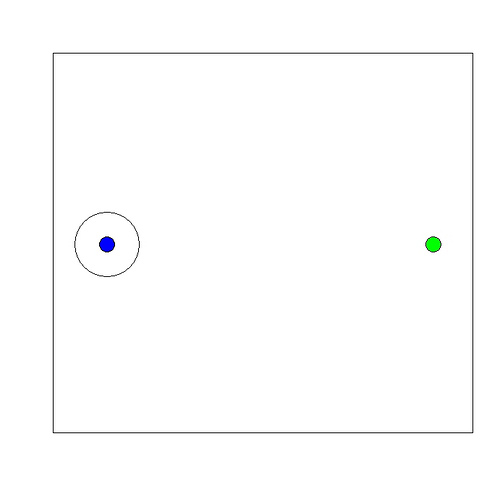
You begin by moving the cursor to the green circle. Then with one movement — one fingerstroke — you move the cursor as close as possible to the blue circle. You “toss” it at the blue circle. You click where it ends up. It’s a lot like free-throw shooting and darts. You do that again and again; at the moment each test session consists of 35 “tosses”.
The outer circle around the blue circle is based on the previous 200 trials; the radius of that circle is the median distance. If I’m improving, I’ll be within the outer circle more than half the time.
Here are sample results (from the most recent session).
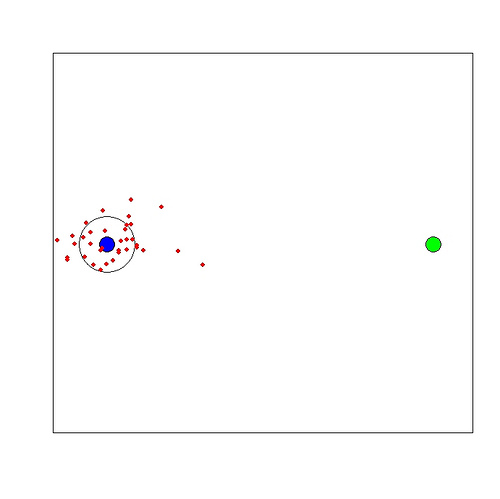
Here is my learning curve. The y axis is the average distance from where the cursor landed to the middle of the blue circle. The bars show standard errors.
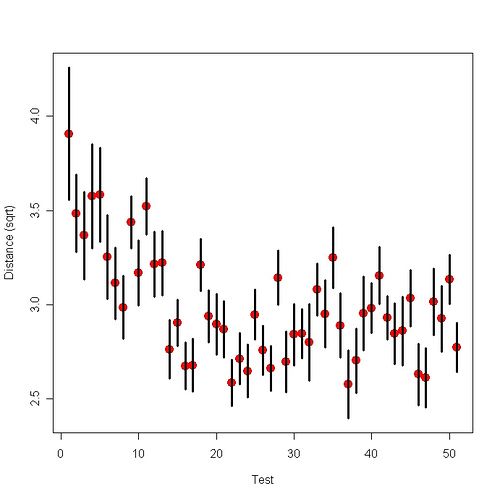
I have collected a lot of data in my life. This particular dataset (data from about 1700 trials) was the easiest. To my great surprise, this exceedingly simple game is great fun! I have to push myself to not do it.
What makes games addictive? This game has 1. Hand-eye coordination. 2. Feedback. 3. Difficulty. It doesn’t have 1. Variety. 2. Action.
Part 1. Part 3: Interpreting the results.
Addendum. A poem called “ Needle’s Eye” in this week’s New Yorker ends like this:
what does it matter how big
a target you are? Someone somewhere
will invent a game to make you hard to hit.
Drug addiction, sure. The first pleasurable drugs were probably discovered hundreds of thousands of years ago, if not much earlier. All cultures use drugs. Drugs physically reach the brain. But video game addiction? Video games are a millisecond old, compared to drugs. How did they get so potent so fast?
Self-experimentation made me ask. Using an ordinary psychological test and a speeded arithmetic task, I discovered a fast-acting effect of flaxseed oil. About two hours after ingestion of 4 tablespoons, my brain worked detectably better. The effect wore off over several hours. To properly study this effect, and exploit it to learn more about what fats we should eat (which has been very hard to figure out), I would have to test myself many times per day for many days. Thousands of tests. It would be a lot easier if the tests were fast, portable, and fun — especially fun. Many computer games have these traits. But they don’t provide the data I need, which is a measure of how well my brain is working, and they take too long.
After talking with Greg Niemeyer, I came up with four properties, shared by many games, that might be why they are fun: 1. Right difficulty level. Neither too easy nor too hard. This is a variable emphasized by Mihaly Csikszentmihalyi in Flow. 2. Feedback. You learn how well you are doing. 3. Variety. Not the same thing over and over. 4. Color. I constructed a task with all four features. To my dismay, it wasn’t fun! (So much for the placebo effect.) I had to force myself to do it.
I had no idea what was wrong. Then, as I’ve written, a friend gave me a bilboquet, which led me to think that there were two principles of fun-making I’d left out: 1. Hand-eye coordination. We enjoy tasks that involve this. 2. Completion. We enjoy tasks where something is cleared up or put neatly together.
I used these ideas to construct a new test. It consisted of moving the cursor around the screen from one colored circle to the next. I move the cursor to a circle and click on it. That circle disappears and a new circle appears somewhere else. It’s a bit like shooting one circle after another. Aim, click, aim, click. Each circle is effectively a new trial. The speed at which I moved the cursor to the new circle and click on it is the main measure. There is trial-by-trial feedback: the color of the next circle depends on how quickly I got to the last circle. Here’s a screen shot (cursor not shown):
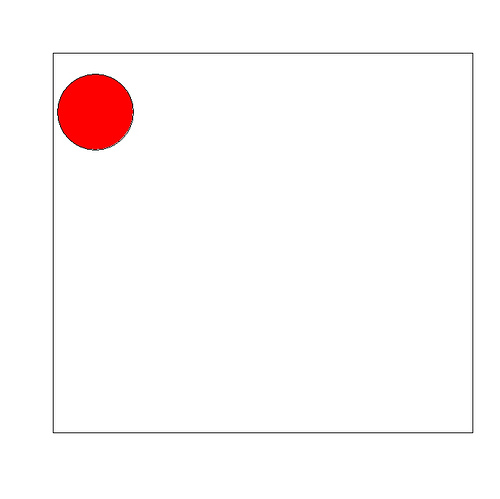
I did this on a Thinkpad. I used the trackpoint to move the cursor. This had the pleasant feature that there was no obvious learning curve — I didn’t improve with practice. Presumably because I have years of practice with the trackpoint
Eventually I got around to the big question: Was this test sensitive to the effects of flaxseed oil? I’ve done two series of measurements to answer this. Here are the results from the first series:
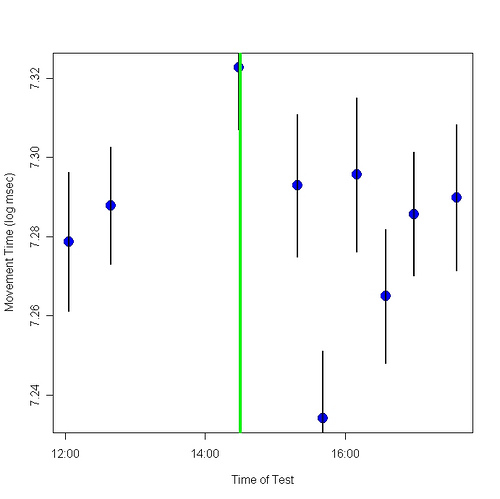
The green line shows when I drank 4 tablespoons of flaxseed oil (without lignans). Here are the results from the second series:
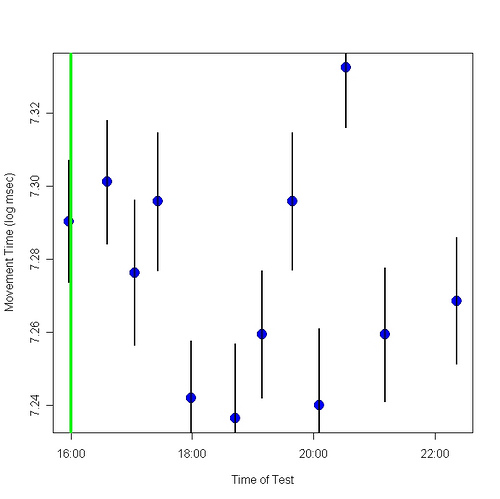
Again, the green line shows when I drank 4 tablespoons of flaxseed oil.
Both times the results resembled my previous results. The flaxseed oil appeared to cause a decrease (= improvement), which reached a maximum around 2 hours after ingestion and declined. The results were far from beautiful but because of the similarity to earlier results (here, here, and here) I found them fairly persuasive. They certainly suggest doing more with this test.
Then I made a different game…
These are the supplies I used in my calorie-learning experiments:
1. Wonder bread. I wanted bread with as little flavor as possible
2. Unsalted butter. Unsalted because the spice blends have salt.
3. Eleven Penzeys Spices spice blends. In particular, Baking Spice, Cake Spice, Chicken Taco Seasoning, Jerk Pork Seasoning, Poultry Seasoning, Mural of Flavor, Sate Seasoning, Southwest Seasoning, Sweet Curry (regular), Tuscan Sunset, Venison Sausage Seasoning. Each has 5-15 different spices. For example, Jerk Pork Seasoning contains paprika, allspice, ginger, cayenne pepper, sugar, nutmeg, black pepper, garlic, thyme, lemon grass, cinnamon, star anise, cloves, and mace. Baking Spice is a mixture of two kinds of cinnamon, anise seed, allspice, mace, and cardamom. Combining a few of them should produce a flavor unlikely to resemble any familiar flavor.
In a series of posts, each titled Calorie Learning: [something], I’m going to use a blog to communicate self-experimentation. To see the whole series, look in the category Calorie Learning (under Self-Experimentation).
This research will be about how we (or at least I) learn to associate flavors with calories — more precisely, smells with calories. This learning is at the heart of the Shangri-La Diet, which derives from a theory that says the flavors of your food increase your set point if they are associated with calories. The stronger the association, the bigger the increase.
Why study this? 1. Maybe I can improve the diet. 2. It matters. It happens with every bit of food you eat. It controls what you eat and your appearance (assuming my theory is right). 3. Little is known about it. As I wrote in the appendix to The Shangri-La Diet, Anthony Sclafani has studied this learning extensively in rats. No one has studied it extensively in people. 4. The experiments can be simple and easy — or at least that’s what I think now.
A few weeks ago, a friend told me how much she liked those cellophane-wrapped white-bread sandwiches sold in delis and bodegas. Egg salad sandwiches, for example. They were addictive, she said. That sounded about right: White bread (and bread in general) is digested very fast, witness its very high glycemic index. Fast digestion means the calorie signal it generates in the brain overlaps a great deal with the flavor signal it generates in the brain. The more overlap of the two signals, the stronger the association created. The stronger a flavor’s association with calories, the more you like it.
Her comment gave me an idea: I can create a random new flavor by randomly combining many spices, mixing them into butter, and spreading the butter on white bread. The spices supply the flavor, which I can reproduce as often as I want by making a big enough batch of spicy butter when I start. Spice mixtures are cheap. I can easily and cheaply make a huge number of flavors that should taste entirely new. This means I can start fresh — which is where you want to start when doing a learning experiment — as often as I want. White bread is cheap, easily available, has little flavor, and provides a strong signal per calorie. If I want to increase the time between the flavor and the calories, maybe I can spread the butter on crackers, which have few calories, and eat the bread later.
Will it work? Stay tuned.
I’d like to increase the ability of self-experimenters to tell others what they’ve done and get feedback. Blog software can be used to do this.
Instead of posting again and again, as in the usual blog, you just post a few times then edit those posts as you collect new information. Instead of post = diary entry, the concept is post = section of scientific paper. You might have posts corresponding to Introduction, Equipment, Procedure, Raw Data, Data Summary, Interpretation, Strengths, Weaknesses, and Comparison to Other Work. You start by writing the Introduction. As the raw data comes in, you add it to the Raw Data post. After you finish collecting the raw data, you write the Data Summary post. And so on.
Here is the start of an example.
The special offer is that if you want to do a self-experiment and are willing to communicate your results in this form, I will — time permitting — help you do it and write it up and will link to the blog you create. To take advantage of this offer, write me at twoutopias at gmail dot com. Tell me what you want to do and your relevant background. Deadline: Sunday, February 24.
What I like most about magazines is their ability to open new worlds to me. Books — unless by Jane Jacobs — rarely do this. Music, TV, and movies almost never do this. Paintings and other visual arts never do this (to me). Magazines do this regularly. Entertainment Weekly — the best magazine with a dull name — tries to do this (and succeeds). I am now reading The Golden Compass because of EW. An issue of Colors made me visit Iceland. Spy made New York fascinating. (E.g., an NYC map of smells.) It’s the best kind of teaching: you open a door and make what’s inside seem so interesting and wonderful that the student voluntarily decides to enter and explore.
Which is why it isn’t completely surprising that Abu Ayyub Ibrahim, who writes Behind the Approval Matrix, is a teacher. New York magazine’s Approval Matrix has a wonderful way of introducing new things: with humor, poetry (if well-written short captions = poetry), a dash of outrage (calling stuff “despicable”), and an attractive layout. When it calls something Brilliant, I’m instantly curious — thus fulfilling the best function of magazines with remarkable ease. The problem for me, and I assume many others, is that the captions are often obscure. Behind the Approval Matrix — which might have been called The Annotated Approval Matrix — explains each item.
The creators of The Approval Matrix had a great idea and didn’t quite pull it off. It’s often too hard to figure out what they’re talking about. Ibrahim has supplied what is missing.
It’s a bit like my self-experimentation. Previous (conventional) research, for various reasons, couldn’t quite reach practical applications (e.g., omega-3 research couldn’t figure out the best dose); my self-experimentation, building on that research, was able to cover the final mile.